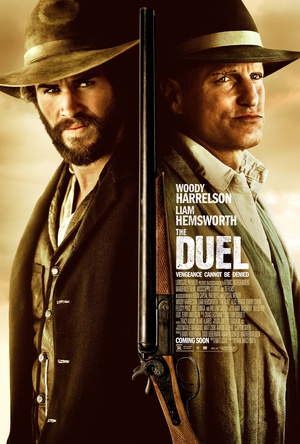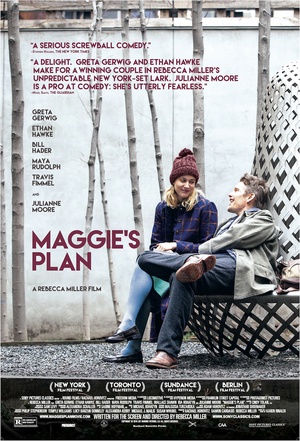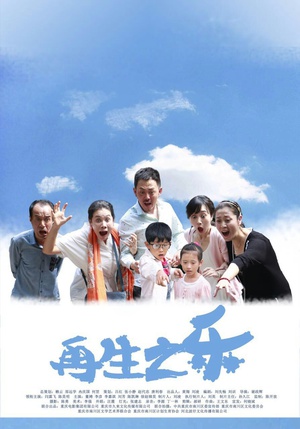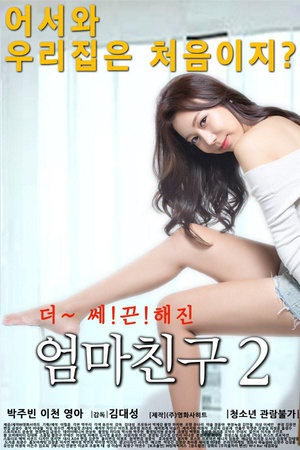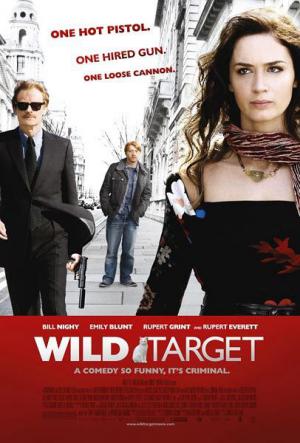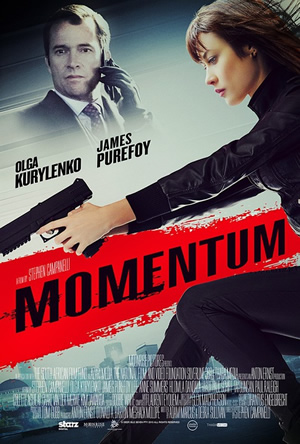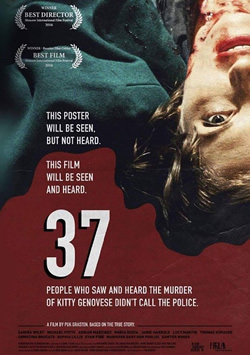
At feature length, Puk Grasten’s 37 reconstructs events that took place on March 12 and 13, 1964, in the Kew Gardens neighborhood near Austin Street and the station for the Long Island Railroad. But while the murder of Kitty Genovese might be the most unusual of those events, 37 focuses on the stories and people that surround and bear witness to that horrific act. We see what they see, throughout the day and night. From those many perspectives, the deeper meanings of the Kitty Genovese story – and as it speaks to us today – emerge with new urgency. Just as recent acclaimed films such as Lincoln and Selma have asked us to consider turning points in American history through the prism of contemporary social issues, 37 reimagines the Genovese story through that same historicized lens, as well as the eyes of witnesses to history.
Grasten explains: “With the short film, I was able to explore mood, characters and take on that challenge: how much can you tell the story of Kitty Genovese without her being the main character? And the answer was to further explore the bystanders, to put yourself in that situation.”
Returning to her native country, Denmark, Grasten found development support from New Danish Screen ,the indie department at the Danish Film Institute, which allowed her to fund pre-production and start bringing the project to life. As a feature, 37 is not intended to be documentary or precise reenactment. While some of the actions and general descriptions of the dozen principle figures in the film have some historical parallel, the characters have fictional names and circumstances, except for Kitty Genovese. This reimagination of the event, framed from so many different perspectives, meant giving each character, family, and even specific location a unique look. While certain scenes in 37 will remind viewers of fly-on-the-wall cinema verité, other sequences are more stylized. Grasten began that process of differentiating perspectives by developing a visual “mood book”. “We wanted it to feel like separate worlds for each family – we refer to it as a POV film, with specifically different perspectives from the adults, the children, and the buildings. I rewrote the script specifically with those POVs in mind, trying to capture that subjective experience. These different points of view, different filters, convey different emotions and reactions”.
The visually inspired production concept helped fuel the creative process on-set during the film’s 18-day shooting schedule. “Everyone on the crew had their favorite family or character,” the filmmaker says. “They all found themselves identifying strongly with one perspective or another. It was interesting to see how they discussed or defended different characters ‘actions based on their own life and believes.”
It also helped that Grasten worked with a talented team of actors who understand how to craft deep characters through focused ensemble work, and the ability to inhabit their characters naturally and organically. That can be a particularly vexing challenge when working with children, who populate the film and whose perspectives occupy a great deal of screen time. Already dealing with traumatic issues and finding it difficult to navigate with and understand the adult world, their witnessing of the attack and murder on their young, vivacious neighbor proves especially complex to evoke from young performers under the age of 12.
Puk Grasten explains that the child characters are really the central thread of the film – “They are the ones being taught by circumstances. Combining their perspectives, they become one person when witnessing the murder – Troy hears everything, Billy sees everything, Debbie physically tries to get to Kitty. When they seek the truth, they are confronted with doors shut in their faces. “I’ve worked with kids in short films before, and have used a lot of improvisation and creative games,” Grasten says of nurturing her younger cast members. “I knew I wouldn’t be able to work with these young actors for a long time to deeply develop their characters, so I had to rely a lot on their ability to play along. During auditions, I was interested in the ones who weren’t just saying the words, but wanted to take time to listen and respond. That also meant spending time with the parents, adapting the script where I needed to, and really focusing on the kids before, during, and after each take. By the time we got to the end and the more difficult scenes, I think we all trusted each other enough to get the kids where they needed to be”.
“I had some of the actors in mind when I was writing the script, because I knew their work, but actually getting a chance to work and create with them were a huge opportunity. They felt like real people who lived in that neighborhood, and the creation of their characters extended to costume, makeup, props we all found together. It was a very organic process, and with the liberty of the camera, we could get a lot done – shooting rehearsals, improvising, finding great, real moments that weren’t in the script.”
The detail extended to the neighborhood where 37 was filmed. State law understandably prohibits filmmakers from recreating real-life crimes in the exact locations where they occurred, so Grasten’s crew made do with similar looking buildings and structures located in Forest Hills, just to the north of Kew Gardens.
As the story of Kitty Genovese is reconsidered through the eyes of the characters of 37, Grasten is confident that the film will foster positive and productive discussion despite its still difficult subject matter. “This story is the beginning of what’s going on today, where we see everyone hiding and pointing fingers at others, and we say ‘it’s horrible but someone else will take care of it. We’re behind closed doors, in our own groups, liking things on Facebook. So I’m hoping we can use Kitty Genovese as a place to begin the conversation about how we are asked to stay in our place, instead of being asked to make things right. What is it about everyday life that we refuse to see when bad things happen? Why is it that if we can’t care about ‘everything,’ we can’t care about anything?”
Grasten explains: “With the short film, I was able to explore mood, characters and take on that challenge: how much can you tell the story of Kitty Genovese without her being the main character? And the answer was to further explore the bystanders, to put yourself in that situation.”
Returning to her native country, Denmark, Grasten found development support from New Danish Screen ,the indie department at the Danish Film Institute, which allowed her to fund pre-production and start bringing the project to life. As a feature, 37 is not intended to be documentary or precise reenactment. While some of the actions and general descriptions of the dozen principle figures in the film have some historical parallel, the characters have fictional names and circumstances, except for Kitty Genovese. This reimagination of the event, framed from so many different perspectives, meant giving each character, family, and even specific location a unique look. While certain scenes in 37 will remind viewers of fly-on-the-wall cinema verité, other sequences are more stylized. Grasten began that process of differentiating perspectives by developing a visual “mood book”. “We wanted it to feel like separate worlds for each family – we refer to it as a POV film, with specifically different perspectives from the adults, the children, and the buildings. I rewrote the script specifically with those POVs in mind, trying to capture that subjective experience. These different points of view, different filters, convey different emotions and reactions”.
The visually inspired production concept helped fuel the creative process on-set during the film’s 18-day shooting schedule. “Everyone on the crew had their favorite family or character,” the filmmaker says. “They all found themselves identifying strongly with one perspective or another. It was interesting to see how they discussed or defended different characters ‘actions based on their own life and believes.”
It also helped that Grasten worked with a talented team of actors who understand how to craft deep characters through focused ensemble work, and the ability to inhabit their characters naturally and organically. That can be a particularly vexing challenge when working with children, who populate the film and whose perspectives occupy a great deal of screen time. Already dealing with traumatic issues and finding it difficult to navigate with and understand the adult world, their witnessing of the attack and murder on their young, vivacious neighbor proves especially complex to evoke from young performers under the age of 12.
Puk Grasten explains that the child characters are really the central thread of the film – “They are the ones being taught by circumstances. Combining their perspectives, they become one person when witnessing the murder – Troy hears everything, Billy sees everything, Debbie physically tries to get to Kitty. When they seek the truth, they are confronted with doors shut in their faces. “I’ve worked with kids in short films before, and have used a lot of improvisation and creative games,” Grasten says of nurturing her younger cast members. “I knew I wouldn’t be able to work with these young actors for a long time to deeply develop their characters, so I had to rely a lot on their ability to play along. During auditions, I was interested in the ones who weren’t just saying the words, but wanted to take time to listen and respond. That also meant spending time with the parents, adapting the script where I needed to, and really focusing on the kids before, during, and after each take. By the time we got to the end and the more difficult scenes, I think we all trusted each other enough to get the kids where they needed to be”.
“I had some of the actors in mind when I was writing the script, because I knew their work, but actually getting a chance to work and create with them were a huge opportunity. They felt like real people who lived in that neighborhood, and the creation of their characters extended to costume, makeup, props we all found together. It was a very organic process, and with the liberty of the camera, we could get a lot done – shooting rehearsals, improvising, finding great, real moments that weren’t in the script.”
The detail extended to the neighborhood where 37 was filmed. State law understandably prohibits filmmakers from recreating real-life crimes in the exact locations where they occurred, so Grasten’s crew made do with similar looking buildings and structures located in Forest Hills, just to the north of Kew Gardens.
As the story of Kitty Genovese is reconsidered through the eyes of the characters of 37, Grasten is confident that the film will foster positive and productive discussion despite its still difficult subject matter. “This story is the beginning of what’s going on today, where we see everyone hiding and pointing fingers at others, and we say ‘it’s horrible but someone else will take care of it. We’re behind closed doors, in our own groups, liking things on Facebook. So I’m hoping we can use Kitty Genovese as a place to begin the conversation about how we are asked to stay in our place, instead of being asked to make things right. What is it about everyday life that we refuse to see when bad things happen? Why is it that if we can’t care about ‘everything,’ we can’t care about anything?”
- 像似影片
- 同主演
- 同导演
